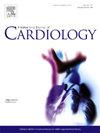经导管器械植入治疗的狭窄、锥形、剑突型双尖瓣的特征、尺寸和疗效:AD HOC 登记的启示。
IF 3.2
2区 医学
Q2 CARDIAC & CARDIOVASCULAR SYSTEMS
引用次数: 0
摘要
背景:剑突型双尖瓣主动脉瓣(BAV)是经导管主动脉瓣置换术(TAVR)的潜在危险情况,原因是钙负荷明显,可能与锥形瓣膜结构有关。对于这种瓣膜亚型,经导管心脏瓣膜(TAV)的尺寸选择策略(环状瓣膜与环上瓣膜)存在争议:目的:描述接受 TAVR 的严重锥形剑突型 BAV 狭窄患者的表型特征,探讨新一代 THV 的安全性和有效性,分析环形和环上尺寸策略对短期和中期预后的影响:这是一项回顾性多中心登记,纳入了接受 TAVR 治疗的连续性狭窄 Sievers 1 型 BAV。根据 MSCT 分析,研究对象分为锥形和非锥形结构。在锥形人群中,对环形和环上尺寸组进行了匹配比较:从 2016 年 1 月到 2023 年 6 月,共有 897 名患者入组。其中,696 名患者显示为锥形结构。其中,510 人根据环形尺寸接受了 THV。经过倾向评分匹配后,选出了 186 对匹配患者。技术成功率(96.2% vs 94.1%,OR 1.61 [0.61-4.24],p = 0.34)、30 天设备成功率(两组均为 83.6%,OR 1.42 [0.78-2.57],p = 0.25)和 30 天早期安全性(71.8% vs 70.5%,OR 1.07 [0.78-2.57],p = 0.25)均高于对照组。5%,OR 1.07 [0.68-1.68],p = 0.78)相似;观察到环上组 TAVR 术后梯度更高,尽管平均仅为 2 mmHg。在中期随访中,临床有效率为84.7%:结论:使用新一代设备进行 TAVR 对锥形剑突型 BAV 安全有效,瓣环和瓣上尺寸策略的效果相当。本文章由计算机程序翻译,如有差异,请以英文原文为准。
CharActeristics, sizing anD outcomes of stenotic, tapered, rapHe-type bicuspid aOrtic valves treated with trans-catheter device implantation: Insights the AD HOC registry
Background
Raphe-type bicuspid aortic valve (BAV) is a potential hostile scenario in trans-catheter aortic valve replacement (TAVR) due to pronounced calcium burden, possibly associated with tapered valve configuration. Trans-Catheter heart valve (THV) sizing strategy (annular vs. supra-annular) is controversial in this valve subtype.
Objectives
To describe the phenotypical characteristics of severe, tapered, raphe-type, BAV stenosis undergoing TAVR and to explore safety and efficacy of modern-generation THVs, analysing the impact of annular and supra-annular sizing strategies on short- and mid-terms outcomes.
Methods
This is a retrospective, multicenter registry enrolling consecutive stenotic Sievers type 1 BAV treated with TAVR. Study population was divided into tapered and non-tapered configuration according to MSCT analysis. Matched comparison between annular and supra-annular sizing groups was performed in tapered population.
Results
From January 2016 to June 2023, 897 patients were enrolled. Of them, 696 patients displayed a tapered configuration. Of those, 510 received a THV according to annular sizing. After propensity score matching 186 matched pairs were selected. Technical success (96.2 % vs 94.1 %, OR 1.61 [0.61–4.24], p = 0.34), 30-day device success (83.6 % in both groups, OR 1.42 [0.78–2.57], p = 0.25) and 30-day early safety (71.8 % vs 70.5 %, OR 1.07 [0.68–1.68], p = 0.78) were similar between the annular and supra-annular sizing groups; a higher post-TAVR gradient was observed in supra-annular group, although it was only 2 mmHg mean. At mid-term follow-up, the rate of clinical efficacy was 84.7 %.
Conclusions
TAVR with modern-generation devices is safe and effective for tapered raphe-type BAV, showing comparable results for annular and supra-annular sizing strategies.
求助全文
通过发布文献求助,成功后即可免费获取论文全文。
去求助
来源期刊

International journal of cardiology
医学-心血管系统
CiteScore
6.80
自引率
5.70%
发文量
758
审稿时长
44 days
期刊介绍:
The International Journal of Cardiology is devoted to cardiology in the broadest sense. Both basic research and clinical papers can be submitted. The journal serves the interest of both practicing clinicians and researchers.
In addition to original papers, we are launching a range of new manuscript types, including Consensus and Position Papers, Systematic Reviews, Meta-analyses, and Short communications. Case reports are no longer acceptable. Controversial techniques, issues on health policy and social medicine are discussed and serve as useful tools for encouraging debate.
 求助内容:
求助内容: 应助结果提醒方式:
应助结果提醒方式:


